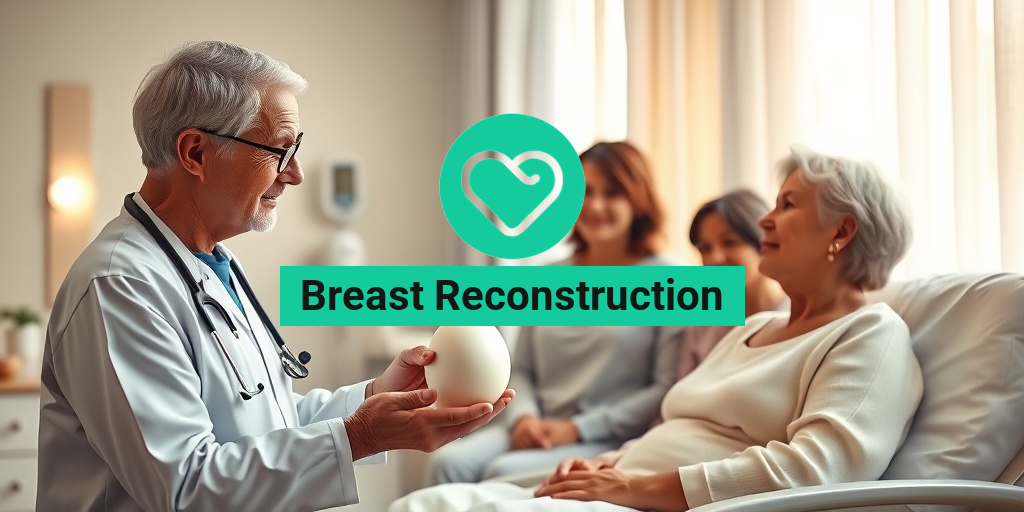What Is Breast Reconstruction?
Breast reconstruction is a surgical procedure aimed at restoring the shape and appearance of a breast after it has been removed or altered due to cancer treatment, trauma, or congenital conditions. This transformative surgery can significantly impact a person’s emotional and psychological well-being, helping them regain confidence and a sense of normalcy.
There are various techniques for breast reconstruction, and the choice often depends on individual circumstances, including the type of mastectomy performed, the patient’s body type, and personal preferences. The two primary methods of breast reconstruction are:
- Implant-based reconstruction: This involves placing silicone or saline implants to create a new breast mound.
- Flap reconstruction: This technique uses tissue from another part of the body (such as the abdomen, back, or thighs) to reconstruct the breast.
Breast reconstruction can be performed immediately after a mastectomy or delayed until a later date, depending on the patient’s health and treatment plan. Many women find that undergoing reconstruction helps them feel more complete and can aid in the healing process after a traumatic experience.
Reasons for Breast Reconstruction
There are several compelling reasons why individuals may choose to undergo breast reconstruction. Understanding these motivations can help patients make informed decisions about their treatment options. Here are some of the most common reasons:
1. Restoring Body Image
One of the primary reasons for breast reconstruction is to restore a woman’s body image after a mastectomy. Losing a breast can lead to feelings of loss and diminished self-esteem. Reconstruction can help individuals feel more like themselves again, enhancing their confidence and overall quality of life.
2. Psychological Well-being
The emotional impact of breast cancer and its treatment can be profound. Many women report feeling more empowered and positive after undergoing reconstruction. This surgery can serve as a significant step in the healing journey, allowing individuals to reclaim their identity and move forward with their lives.
3. Clothing and Fashion Choices
After a mastectomy, some women may find it challenging to wear certain types of clothing or swimwear. Breast reconstruction can help restore a more natural silhouette, making it easier to wear a wider variety of outfits and feel comfortable in social situations.
4. Improved Physical Comfort
For some women, the absence of a breast can lead to physical discomfort or asymmetry. Breast reconstruction can alleviate these issues, providing a more balanced appearance and improving overall comfort.
5. Personal Empowerment
Choosing to undergo breast reconstruction can be an empowering decision. It allows individuals to take control of their bodies and their recovery process, making a choice that aligns with their personal values and desires.
6. Support from Healthcare Providers
Many healthcare providers encourage patients to consider breast reconstruction as part of their treatment plan. Surgeons specializing in breast reconstruction can provide valuable insights and support, helping patients navigate their options and make informed decisions.
In conclusion, breast reconstruction is a significant step for many individuals recovering from breast cancer or other breast-related issues. Whether motivated by the desire to restore body image, improve psychological well-being, or regain comfort in clothing choices, the decision to undergo reconstruction is deeply personal. For those considering this option, consulting with experienced breast reconstruction surgeons can provide essential guidance and support.
For more information on breast reconstruction options and to find resources tailored to your needs, consider visiting Yesil Health AI, where you can access evidence-based health answers and support.
Remember, you are not alone in this journey, and there are many resources available to help you navigate your options. 🌸

Types of Breast Reconstruction
Breast reconstruction is a vital option for many women who have undergone a mastectomy or lumpectomy due to breast cancer. It aims to restore the shape and appearance of the breast, helping to improve self-esteem and body image. There are several types of breast reconstruction, each with its own benefits and considerations. Let’s explore the most common options available.
1. Implant-Based Reconstruction
Implant-based reconstruction is one of the most popular methods. This procedure involves placing a silicone or saline implant under the chest muscle to create a new breast shape. It can be performed immediately after a mastectomy or at a later date.
- Immediate Reconstruction: This occurs during the same surgery as the mastectomy, allowing for a single recovery period.
- Delayed Reconstruction: This option is chosen if the patient needs additional treatments, such as radiation, before reconstruction.
2. Flap Reconstruction
Flap reconstruction uses the patient’s own tissue to create a new breast. This method can provide a more natural look and feel compared to implants. There are several types of flap procedures:
- TRAM Flap: Tissue is taken from the abdomen to form the breast.
- DIEP Flap: Similar to the TRAM flap, but only skin and fat are used, preserving the abdominal muscles.
- Latissimus Dorsi Flap: Tissue is taken from the back, which can be used to create a breast mound.
3. Nipple and Areola Reconstruction
After the breast mound is created, some women may choose to undergo nipple and areola reconstruction. This can be done using local tissue or tattooing techniques to create a realistic appearance. This step is often considered the final touch in the breast reconstruction journey.
Breast Reconstruction Procedure
The breast reconstruction procedure can vary significantly based on the type chosen and the individual’s unique circumstances. Here’s a general overview of what to expect during the process.
Consultation and Planning
The first step in the breast reconstruction journey is a thorough consultation with a qualified surgeon. During this meeting, the surgeon will:
- Discuss the patient’s medical history and current health status.
- Explain the different types of reconstruction options available.
- Help the patient set realistic expectations regarding the outcomes.
Surgery Day
On the day of the surgery, patients will typically be placed under general anesthesia. The specific steps of the procedure will depend on the chosen method:
- For Implant-Based Reconstruction: The surgeon will create a pocket in the chest wall and insert the implant. If a tissue expander is used, it will be gradually filled with saline over several weeks to stretch the skin.
- For Flap Reconstruction: The surgeon will remove tissue from the donor site (like the abdomen or back) and carefully shape it into a breast mound. This may involve microsurgery to connect blood vessels.
Recovery Process
Recovery times can vary based on the type of reconstruction performed. Generally, patients can expect:
- Hospital Stay: Most patients stay in the hospital for 1 to 3 days post-surgery.
- Activity Restrictions: Patients are advised to avoid heavy lifting and strenuous activities for several weeks.
- Follow-Up Appointments: Regular check-ups with the surgeon are essential to monitor healing and address any concerns.
Breast reconstruction is a deeply personal journey, and understanding the various types and procedures can empower women to make informed decisions about their health and body. Whether opting for implants or flap techniques, the goal remains the same: to restore confidence and a sense of wholeness. 🌸

Recovery After Breast Reconstruction
Undergoing breast reconstruction is a significant step in the journey of healing and reclaiming one’s body after a mastectomy or lumpectomy. Understanding the recovery process can help set realistic expectations and prepare for the changes ahead. Here’s what you need to know about recovery after breast reconstruction.
Initial Recovery Phase
The first few days post-surgery are crucial. Patients typically stay in the hospital for a day or two, depending on the type of reconstruction performed. During this time, medical staff will monitor your vital signs and manage any pain. It’s common to experience:
- Pain and Discomfort: Pain management is essential. Your doctor will prescribe medications to help alleviate discomfort.
- Swelling and Bruising: Expect some swelling and bruising around the surgical site, which is normal and should gradually subside.
- Drainage Tubes: If you had a flap reconstruction, you might have drainage tubes to remove excess fluid. These will be removed during follow-up visits.
At Home Care
Once you return home, it’s important to follow your surgeon’s post-operative instructions carefully. Here are some tips for a smooth recovery:
- Rest: Prioritize rest and avoid strenuous activities for at least 4-6 weeks.
- Follow-Up Appointments: Attend all scheduled follow-up appointments to monitor your healing progress.
- Wound Care: Keep the surgical area clean and dry. Follow your doctor’s guidelines on how to care for your incisions.
- Nutrition: Maintain a balanced diet rich in vitamins and minerals to support healing.
Emotional Recovery
Recovery isn’t just physical; emotional healing is equally important. Many women experience a range of emotions, from relief to anxiety. Consider joining support groups or speaking with a therapist who specializes in post-cancer care. Connecting with others who have undergone breast reconstruction can provide comfort and understanding. 💖
Potential Risks and Complications
Like any surgical procedure, breast reconstruction surgery carries potential risks and complications. Being informed can help you make educated decisions and prepare for any challenges that may arise.
Common Risks
Some of the common risks associated with breast reconstruction include:
- Infection: Surgical sites can become infected, leading to complications that may require additional treatment.
- Bleeding: Excessive bleeding during or after surgery can occur, necessitating further intervention.
- Scarring: While scars are a natural part of the healing process, some individuals may experience more noticeable scarring than others.
Specific Complications
Depending on the type of reconstruction performed, there may be specific complications to consider:
- Flap Failure: In flap reconstruction, the tissue used may not receive adequate blood supply, leading to tissue death.
- Asymmetry: Some patients may notice differences in size or shape between the reconstructed breast and the natural breast.
- Loss of Sensation: Nerve damage during surgery can lead to changes in sensation in the breast or surrounding areas.
Long-Term Considerations
It’s essential to have ongoing discussions with your healthcare team about any long-term effects of breast reconstruction. Regular check-ups can help monitor your health and address any concerns that may arise over time. Remember, every individual’s experience is unique, and being proactive about your health is key. 🩺
In conclusion, while the journey of recovery after breast reconstruction can be challenging, understanding the process and potential risks can empower you to navigate this new chapter with confidence. Always consult with your healthcare provider for personalized advice and support tailored to your specific situation.

Breast Reconstruction and Emotional Well-being
Breast reconstruction is not just a physical journey; it significantly impacts emotional well-being as well. For many women, undergoing a mastectomy or lumpectomy can lead to feelings of loss, anxiety, and depression. Understanding the emotional aspects of breast reconstruction is crucial for holistic recovery.
The Psychological Impact of Breast Surgery
After a breast surgery, many women experience a range of emotions. It’s common to feel:
- Sadness: The loss of a breast can lead to feelings of grief.
- Anxiety: Concerns about body image and the future can be overwhelming.
- Isolation: Some women may feel disconnected from their bodies or from others.
These feelings are valid and should be addressed. Engaging in open conversations with healthcare providers, family, and friends can help alleviate some of these emotional burdens. Support groups specifically for breast cancer survivors can also provide a sense of community and understanding.
The Role of Breast Reconstruction in Emotional Healing
Breast reconstruction can play a pivotal role in restoring a woman’s sense of self. Here are some ways it contributes to emotional well-being:
- Restoration of Body Image: Many women report feeling more confident and feminine after reconstruction.
- Closure: The procedure can symbolize a new beginning after cancer treatment.
- Empowerment: Taking control of one’s body can lead to a sense of empowerment and resilience.
It’s essential to discuss your feelings and expectations with your surgeon. They can provide insights into what to expect during the recovery process and how to manage emotional challenges.
Choosing the Right Surgeon
Choosing the right surgeon for your breast reconstruction is a critical step in the journey. The right professional can make a significant difference in both the physical and emotional outcomes of the procedure.
Factors to Consider When Selecting a Surgeon
When looking for a breast reconstruction surgeon, consider the following factors:
- Experience: Look for a surgeon who specializes in breast reconstruction and has extensive experience with various techniques.
- Board Certification: Ensure the surgeon is board-certified in plastic surgery, which indicates a high level of training and expertise.
- Patient Reviews: Read testimonials and reviews from previous patients to gauge their satisfaction and experiences.
- Communication: Choose a surgeon who listens to your concerns and explains the procedures clearly.
Types of Breast Reconstruction Techniques
Understanding the different types of breast reconstruction can help you make an informed decision. Here are some common options:
- Implant Reconstruction: This involves placing silicone or saline implants to create a new breast shape.
- Flap Reconstruction: This technique uses tissue from other parts of the body (like the abdomen or back) to reconstruct the breast.
- Autologous Reconstruction: Similar to flap reconstruction, this method uses your own tissue, which can lead to a more natural look and feel.
Discuss these options with your surgeon to determine which method aligns best with your body type, lifestyle, and personal preferences.
Consultation and Questions to Ask
During your consultation, it’s essential to ask the right questions to ensure you feel comfortable and informed:
- What are the potential risks and complications associated with the procedure?
- What is the expected recovery time?
- Can you show me before and after pictures of previous patients?
- What support services do you offer for emotional well-being post-surgery?
Choosing the right surgeon is a personal decision that should be made with careful consideration. Take your time, do your research, and trust your instincts. Your emotional and physical health is paramount, and the right surgeon can help you navigate this journey with confidence. 🌟

Frequently Asked Questions about Breast Reconstruction
What is Breast Reconstruction?
Breast reconstruction is a surgical procedure that aims to restore the shape and appearance of the breast after a mastectomy or lumpectomy. This procedure can help improve the emotional and psychological well-being of individuals who have undergone breast cancer treatment.
When is Breast Reconstruction Performed?
Breast reconstruction can be performed either at the same time as a mastectomy (immediate reconstruction) or at a later date (delayed reconstruction). The timing depends on various factors, including the patient’s health, cancer treatment plan, and personal preferences.
What are the Different Options for Breast Reconstruction?
- Implant-based reconstruction: This involves using silicone or saline implants to create a new breast shape.
- Flap reconstruction: This technique uses tissue from other parts of the body (such as the abdomen or back) to reconstruct the breast.
- Combination methods: Some patients may opt for a combination of implants and flap techniques for optimal results.
What is the Recovery Process Like?
The recovery process varies depending on the type of reconstruction performed. Generally, patients can expect some swelling and discomfort, which can be managed with medication. Most individuals can return to normal activities within a few weeks, but full recovery may take several months.
How Much Does Breast Reconstruction Surgery Cost?
The cost of breast reconstruction surgery can vary widely based on factors such as the type of reconstruction, the surgeon’s fees, and the location of the procedure. It’s essential to consult with your healthcare provider and insurance company to understand the potential costs involved.
Are There Any Risks Associated with Breast Reconstruction?
Like any surgical procedure, breast reconstruction carries some risks, including infection, bleeding, and complications related to anesthesia. It’s crucial to discuss these risks with your surgeon to make an informed decision.
How Can I Find a Qualified Breast Reconstruction Surgeon?
To find a qualified breast reconstruction surgeon, consider seeking referrals from your oncologist, checking online reviews, and verifying the surgeon’s credentials and experience in performing breast reconstruction procedures.
Can I See Before and After Pictures of Breast Reconstruction?
Many surgeons provide before and after pictures of their previous patients to help prospective patients understand the potential outcomes of the procedure. It’s advisable to review these images during your consultation.
What is the ICD-10 Code for Breast Reconstruction?
The ICD-10 code for breast reconstruction varies based on the specific procedure performed. It’s best to consult with your healthcare provider or insurance company for the exact code relevant to your situation.
Is Breast Reconstruction Possible After a Lumpectomy?
Yes, breast reconstruction after lumpectomy is possible. The options may differ from those available after a mastectomy, and your surgeon can provide guidance on the best approach for your individual case.




